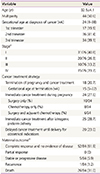2. Weisz B, Meirow D, Schiff E, Lishner M. Impact and treatment of cancer during pregnancy. Expert Rev Anticancer Ther. 2004; 4:889–902.
5. Van Calsteren K, Heyns L, De Smet F, Van Eycken L, Gziri MM, Van Gemert W, et al. Cancer during pregnancy: an analysis of 215 patients emphasizing the obstetrical and the neonatal outcomes. J Clin Oncol. 2010; 28:683–689.
6. Pavlidis NA. Coexistence of pregnancy and malignancy. Oncologist. 2002; 7:279–287.
7. Weisz B, Schiff E, Lishner M. Cancer in pregnancy: maternal and fetal implications. Hum Reprod Update. 2001; 7:384–393.
8. Dunkelberg JC, Barakat J, Deutsch J. Gastrointestinal, pancreatic, and hepatic cancer during pregnancy. Obstet Gynecol Clin North Am. 2005; 32:641–660.
9. US Cancer Statistics Working Group. United States cancer statistics: 1999-2011 incidence and mortality web-based report [Internet]. Atlanta (GA): Department of Health and Human Services, Centers for Disease Control and Prevention and National Cancer Institute;c2014. cited 2014 Dec 24.
http://www.cdc.gov/cancer/npcr/pdf/USCS_FactSheet.pdf.
10. Antonelli NM, Dotters DJ, Katz VL, Kuller JA. Cancer in pregnancy: a review of the literature. Part I. Obstet Gynecol Surv. 1996; 51:125–134.
11. Andersson TM, Johansson AL, Fredriksson I, Lambe M. Cancer during pregnancy and the postpartum period: a population-based study. Cancer. 2015; 121:2072–2077.
12. Eibye S, Kjaer SK, Mellemkjaer L. Incidence of pregnancyassociated cancer in Denmark, 1977-2006. Obstet Gynecol. 2013; 122:608–617.
13. Cardonick E. Pregnancy-associated breast cancer: optimal treatment options. Int J Womens Health. 2014; 6:935–943.
14. Lee HY, Chay WY, Tang MB, Chio MT, Tan SH. Melanoma: differences between Asian and Caucasian patients. Ann Acad Med Singapore. 2012; 41:17–20.
16. Chung JH. Cost-of-illness trend of thyroid gland disease in Korea. Endocrinol Metab (Seoul). 2014; 29:248–250.
17. Han MA, Choi KS, Lee HY, Kim Y, Jun JK, Park EC. Current status of thyroid cancer screening in Korea: results from a nationwide interview survey. Asian Pac J Cancer Prev. 2011; 12:1657–1663.
18. Lishner M. Cancer in pregnancy. Ann Oncol. 2003; 14:Suppl 3. iii31–iii36.
19. Oh SE, Kim HJ, Choi SJ, Oh SY, Roh CR, Kim JH. A case of huge retroperitoneal liposarcoma in pregnancy. Obstet Gynecol Sci. 2014; 57:236–239.
20. Abramowicz JS. Benefits and risks of ultrasound in pregnancy. Semin Perinatol. 2013; 37:295–300.
21. Bulas D, Egloff A. Benefits and risks of MRI in pregnancy. Semin Perinatol. 2013; 37:301–304.
22. ACOG Committee on Obstetric Practice. ACOG Committee Opinion. Number 299, September 2004 (replaces No. 158, September 1995). Guidelines for diagnostic imaging during pregnancy. Obstet Gynecol. 2004; 104:647–651.
23. Fenig E, Mishaeli M, Kalish Y, Lishner M. Pregnancy and radiation. Cancer Treat Rev. 2001; 27:1–7.
24. Brent RL. The effect of embryonic and fetal exposure to Xray, microwaves, and ultrasound: counseling the pregnant and nonpregnant patient about these risks. Semin Oncol. 1989; 16:347–368.
25. Savas N. Gastrointestinal endoscopy in pregnancy. World J Gastroenterol. 2014; 20:15241–15252.
26. Cappell MS. The fetal safety and clinical efficacy of gastrointestinal endoscopy during pregnancy. Gastroenterol Clin North Am. 2003; 32:123–179.
27. Jaspers VK, Gillessen A, Quakernack K. Gastric cancer in pregnancy: do pregnancy, age or female sex alter the prognosis? Case reports and review. Eur J Obstet Gynecol Reprod Biol. 1999; 87:13–22.
28. Pereg D, Koren G, Lishner M. Cancer in pregnancy: gaps, challenges and solutions. Cancer Treat Rev. 2008; 34:302–312.
29. Malangoni MA. Gastrointestinal surgery and pregnancy. Gastroenterol Clin North Am. 2003; 32:181–200.
30. Amant F, Han SN, Gziri MM, Vandenbroucke T, Verheecke M, Van Calsteren K. Management of cancer in pregnancy. Best Pract Res Clin Obstet Gynaecol. 2015; 29:741–753.
31. Aviles A, Diaz-Maqueo JC, Talavera A, Guzman R, Garcia EL. Growth and development of children of mothers treated with chemotherapy during pregnancy: current status of 43 children. Am J Hematol. 1991; 36:243–248.
32. Lishner M, Koren G. Cancer chemotherapy during pregnancy: consortium of cancer in pregnancy evidence. Can Fam Physician. 2001; 47:41–42.
33. Amant F, Van Calsteren K, Halaska MJ, Gziri MM, Hui W, Lagae L, et al. Long-term cognitive and cardiac outcomes after prenatal exposure to chemotherapy in children aged 18 months or older: an observational study. Lancet Oncol. 2012; 13:256–264.
34. Cunningham FG, editor. Williams obstetrics. 24th ed. New York (NY): McGraw-Hill;2014.





 PDF
PDF ePub
ePub Citation
Citation Print
Print






 XML Download
XML Download